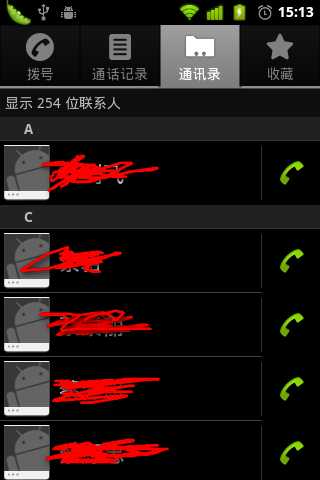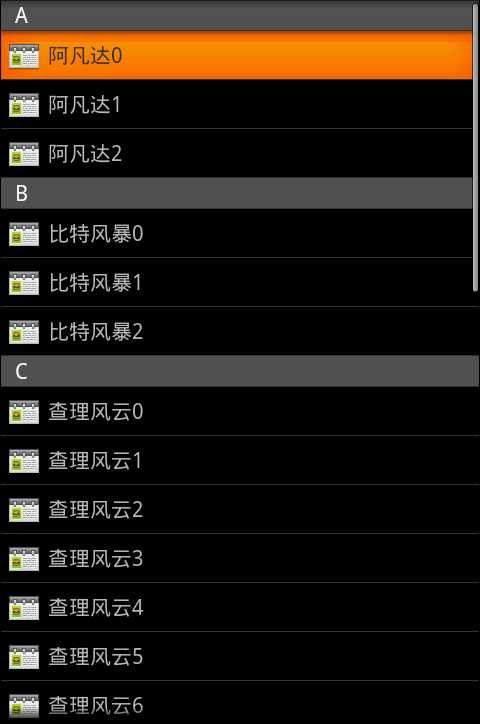标签:
吸引用户的眼球,是我们至死不渝的追求;
第一时间呈现最有价值的信息,简明大方,告诉客户,你的选择是多么的明智,这正是你寻觅已久的东西。
分组的应用场合还是很多的,有数据集合的地方往往要分组显示;
分组的形式也很多,最常见的就是镶嵌在列表中,网上说的很多ExpandListView的也是一种。
Android自带的通讯录中的联系人是按照拼音首字母(A,B,C,D......)分组分类的,效果如下: 我们今天也是要实现这样类似的一个效果。
我们今天也是要实现这样类似的一个效果。
1.样本数据:
为了突出重点,直击要点,这里提供一个整理好的数据样本:
|
1
2
3
4
5
6
7
8
9
10
11
12
13
14
15
16
17
18
19
20
21
22
|
//list:数据集合private List<String> list = new ArrayList<String>();//listTag:Tag集合,其中Tag是分类的分割标签,每个分组的headerprivate List<String> listTag = new ArrayList<String>();public void setData(){ list.add("A"); listTag.add("A"); for(int i=0;i<3;i++){ list.add("阿凡达"+i); } list.add("B"); listTag.add("B"); for(int i=0;i<3;i++){ list.add("比特风暴"+i); } list.add("C"); listTag.add("C"); for(int i=0;i<30;i++){ list.add("查理风云"+i); }} |
2.Activity布局准备:
放置一个listView来呈现数据。
group_list_activity.xml:
|
1
2
3
4
5
6
7
8
9
10
11
12
|
<?xml version="1.0" encoding="utf-8"?> android:orientation="vertical" android:layout_width="fill_parent" android:layout_height="fill_parent" > <!--简单的列表显示--> <ListView android:id="@+id/group_list" android:layout_width="fill_parent" android:layout_height="fill_parent" android:cacheColorHint="#00000000"/></LinearLayout> |
3.自定义Adapter(本文继承ArrayAdapter):
这个是本文的重点和核心。
Adapter接口为数据和界面搭建了一个访问的桥梁,最重要的就是getView()方法,用这个方法我们可以实现一定程度的界面自定义。
ArrayAdapter间接实现了Adapter接口,这里我们简单起见,数据源只是提供单一的String数组。
|
1
2
3
4
5
6
7
8
9
10
11
12
13
14
|
private static class GroupListAdapter extends ArrayAdapter<String>{ //存放标签的列表,用来判断数据项的类型 //如果数据项在标签列表中,则是标签项,否则是数据项 private List<String> listTag = null; public GroupListAdapter(Context context, List<String> objects, List<String> tags) { super(context, 0, objects); this.listTag = tags; } @Override public View getView(int position, View convertView, ViewGroup parent) { ... .... }} |
我们来看看getView方法:
|
1
2
3
4
|
//该方法根据adapter的顺序一行一行的组织列表//其中position表示第几行,也就是当前行在adapter的位置,//convertView表示第几行的ViewView getView(int position, View convertView, ViewGroup parent); |
现在我们就是要重写getView方法,来实现列表中嵌入分组标签。
分组标签也是列表数据项之一,也是被一行一行的画上去的,但是它和其他数据项UI是不一致的,所以我们需要准备2套数据项布局模板:
数据项模板group_list_item.xml:
|
1
2
3
4
5
6
7
8
9
10
11
12
13
14
15
16
17
18
19
|
<?xml version="1.0" encoding="utf-8"?> android:orientation="horizontal" android:layout_width="fill_parent" android:layout_height="wrap_content" android:padding="5dip"> <!-- 图片和文字 --> <!-- 随便放了一张图片,稍微美化一下 --> <ImageView android:src="@drawable/list_icon" android:layout_width="wrap_content" android:layout_height="wrap_content"/> <TextView android:id="@+id/group_list_item_text" android:layout_width="wrap_content" android:layout_height="fill_parent" android:paddingLeft="5dip" android:gravity="center_vertical"/></LinearLayout> |
标签项模板group_list_item_tag.xml:
|
1
2
3
4
5
6
7
8
9
10
11
12
13
14
|
<!-- 只有文字,但是高度小店,背景色设置为555555灰色 --><?xml version="1.0" encoding="utf-8"?> android:layout_width="fill_parent" android:layout_height="wrap_content" android:background="#555555" android:paddingLeft="10dip"> <TextView android:id="@+id/group_list_item_text" android:layout_width="wrap_content" android:layout_height="20dip" android:textColor="#ffffff" android:gravity="center_vertical"/></LinearLayout> |
好,我们现在把这两个模板应用到getView方法中去:
|
1
2
3
4
5
6
7
8
9
10
11
12
13
14
15
16
17
|
@Overridepublic View getView(int position, View convertView, ViewGroup parent) { View view = convertView; //根据标签类型加载不通的布局模板 if(listTag.contains(getItem(position))){ //如果是标签项 view = LayoutInflater.from(getContext()).inflate(R.layout.group_list_item_tag, null); }else{ //否则就是数据项了 view = LayoutInflater.from(getContext()).inflate(R.layout.group_list_item, null); } //显示名称 TextView textView = (TextView) view.findViewById(R.id.group_list_item_text); textView.setText(getItem(position)); //返回重写的view return view;} |
4.禁止标签项的响应事件:
在ArrayAdapter的父类BaseAdapter中提供了isEnable的()方法,我们看看这个方法:
|
1
2
3
4
|
//默认情况,如果这个方法不是分割符,返回true//分隔符是无选中和无点击事件的//说白了,你想不想把改position项当做分隔符,想的话就返回false,否则返回truepublic boolean isEnabled (int position) |
这个方法刚好用来禁用标签项的响应事件。具体实现如下:
|
1
2
3
4
5
6
7
|
@Overridepublic boolean isEnabled(int position) { if(listTag.contains(getItem(position))){ return false; } return super.isEnabled(position);} |
现在标签项不会再有任何触控效果了,犹如一块死木板。
5.完整代码:
整个Activity和Adapter代码如下:
|
1
2
3
4
5
6
7
8
9
10
11
12
13
14
15
16
17
18
19
20
21
22
23
24
25
26
27
28
29
30
31
32
33
34
35
36
37
38
39
40
41
42
43
44
45
46
47
48
49
50
51
52
53
54
55
56
57
58
59
60
61
62
63
64
|
public class GroupListActivity extends Activity { private GroupListAdapter adapter = null; private ListView listView = null; private List<String> list = new ArrayList<String>(); private List<String> listTag = new ArrayList<String>(); @Override protected void onCreate(Bundle savedInstanceState) { super.onCreate(savedInstanceState); setContentView(R.layout.group_list_activity); setData(); adapter = new GroupListAdapter(this, list, listTag); listView = (ListView)findViewById(R.id.group_list); listView.setAdapter(adapter); } public void setData(){ list.add("A"); listTag.add("A"); for(int i=0;i<3;i++){ list.add("阿凡达"+i); } list.add("B"); listTag.add("B"); for(int i=0;i<3;i++){ list.add("比特风暴"+i); } list.add("C"); listTag.add("C"); for(int i=0;i<30;i++){ list.add("查理风云"+i); } } private static class GroupListAdapter extends ArrayAdapter<String>{ private List<String> listTag = null; public GroupListAdapter(Context context, List<String> objects, List<String> tags) { super(context, 0, objects); this.listTag = tags; } @Override public boolean isEnabled(int position) { if(listTag.contains(getItem(position))){ return false; } return super.isEnabled(position); } @Override public View getView(int position, View convertView, ViewGroup parent) { View view = convertView; if(listTag.contains(getItem(position))){ view = LayoutInflater.from(getContext()).inflate(R.layout.group_list_item_tag, null); }else{ view = LayoutInflater.from(getContext()).inflate(R.layout.group_list_item, null); } TextView textView = (TextView) view.findViewById(R.id.group_list_item_text); textView.setText(getItem(position)); return view; } }} |
6.最终效果:
标签:
原文地址:http://www.cnblogs.com/exmyth/p/4510586.html